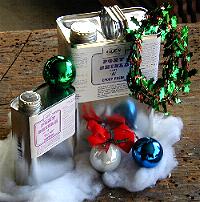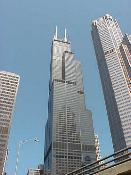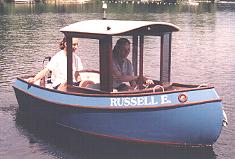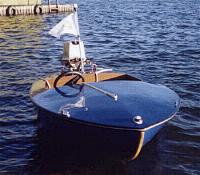
WebLetter 31
An Occasional Publication for the Home Boat Builder
Glen-L Marine Designs - 9152 Rosecrans Ave. - Bellflower, CA 90706
In this issue
- Jingle, jingle...
- Boatbuilding epoxy
- On the Mark: Measuring tools
- Illinois and Missippi Rivers
- Feedback: Tubby Tug
- Designer's Notebook: Self Draining Cockpit
- Another viewpoint: 4-Stroke outboards
- Shop Talk: Building hints from George Remington
- How fast?
- More about models
- Recent email
GLEN-L Update
-
Web site:
- Are you listed in the Project Registry? Mark Bronkalla has commented that he has communicated with several builders who are not in the Registry. The Registry is there to facilitate communication between builders. If we're not available on a weekend, maybe a question can be answered in an email from another builder. Several builders have commented that they've made great friendships with other builders through the Project Registry. Become a part of the community, register your project as soon as you start construction and keep your email address up-to-date.
- There have been a lot of changes to the web site... but you may not notice. The changes mostly involve updating the HTML (page formatting). This is is being done to keep up with new and impending browser technology. This takes a lot of time and has delayed other updates.
- Monte Carlo, barrelback mahogany runabout. I mentioned that the Monte Carlo is currently on the drawingboard in the last WebLetter; I have nothing new to report. There have been several interruptions (normal) and we have as yet no firm date for completion. I will update as we get closer to completion.
- As you scroll down through the WebLetter, you will see the names of several of your fellow builders who have sent in articles. I hope more of you will share your building experiences; your input does help your fellow builders.
-

Kelly Nicole Kaleniki Witt
was born 9-26-01
Kaleniki means strength in Hawaiian
...Grandpa Barry
Barry Witt
Editor
Christmas shopping
It may seem a bit early to bring this up, but our next WebLetter will not be out before the end of November.
It's time to start dropping hints to the shoppers in your family. If you don't take the initiative you may be getting yet another bottle of after shave or tie for your collection. Whether it is Poxy-Shield® epoxy resin, a Fastening or Fiberglass Kit, or accessories for the sailboat you are building, start making your list and checking it twice. The easiest way to get those Glen-L products you need is to put a Glen-L Gift Certificate on your list. Get what you want and make life easier for those who have no idea what to get their favorite boatbuilder.
Gift Certificate information.
Poxy-Shield® - the Boatbuilder's epoxy
When I prepare the WebLetter, I frequently neglect the business part of my job. It is the sale of plans, kits, and supplies that makes the WebLetter and this site possible. We have sections on the site that explain all about our Poxy-Shield® epoxy resin, but it is not uncommon to get email asking what kind of glue to use and where to get it. Poxy-Shield® is a great glue, but it is much more. It is a 5 to 1 mix of resin to hardener and, as so much of the feedback confirms, it is a great product.

As a glue, it is most often used with a filler (we use our #1 Silica) to insure that the mix spans any imperfections. Poxy-Shield® is the resin we use in our Stitch and Glue kits for gluing, fillets, and applying fiberglass laminates. It is the resin we use in our Fiberglass Kits for applying cloth. It is also used for coating wood.
Not only is it a great product, but it's cheaper than the only comparable product on the market. I once asked the chemist at our formulator why there were epoxies that were cheaper, were we getting the best price? The answer was that we could make Poxy-Shield® much less expensive if we added more diluets (solvents)... we didn't. Those who have used it for coating or "pre-coating" before fiberglassing have commented how much harder the surface is and that it is much less likely to sand away the soft grain of plywood if it is coated with epoxy before sanding.
Poxy-Shield® is available with both fast and slow hardener, but slow is by far the most common and best for most applications. Poxy-Shield® comes in three sizes: Quart Kit, Gallon Kit, and 5 Gallon Kit. The volume refects the volume of the resin. Each Kit also includes a 1/5th volume of hardener. Poxy-Shield® can be purchased through our web site, by phone, or through the mail.
| Item Number | Size | Price |
|---|---|---|
| 09-508 | 1.2 Quart Kit | $34.93 |
| 09-509 | 1.2 Gallon Kit | $96.25 |
| 09-510 | 6 Gallon Kit | $432.30 |
| Prices do not include shipping. | ||
For detailed information on Poxy-Shield® and our other epoxy products, see the Epoxy section of our web site.
On the Mark: Boatbuilding Tools - Part 3
Measuring tools
by Mark Bronkalla
Usually when a potential boatbuilder asks what tools are needed, it relates to large power tools. An under appreciated flip side of this is the many small tools that are just as necessary. These are also the tools that you will reach for time and again.
If you have read Wooden Boat for much time, you will have seen several example articles on how to spile a plank with compass or other marking device. Much of the measuring work is simpler, but two over-riding principles apply: make it fit and make it repeatable. One of the hardest things for me to get used to in building the boat was that there are almost no right angles. Lot of curves, and funny compound angles.
I lump the tools into several broad categories:
The Standards:
12' long x 1" wide tape measure
Why this size? Any longer gets too heavy and
clumsy for most work. Less than 1" is too floppy. It just feels
right. I like the Lufkins. A 25' is a nice supplement for a larger
boat, but the vast majority of your work is on shorter distances.
6" tri-square
I use mine a lot as my primary short piece
measuring device. I like the Stanleys. It is so much used (and misplaced)
that I have two.
Combination square
Most people already have one. It is as most
combination tools, a compromise, not terribly accurate for angles (unless
you get a Starrett). The most useful property is as a depth/marking
gauge. Whether measuring the depth of a mortise or setting the blade of
your table saw square to the top, this is a highly useful tool.
6' aluminum rule
Use as a ruler, straight edge, fine batten for
fairing, saw guide, etc. I bought one for the boat, but have used it a
lot since then. As a batten, it is superior to wood for fairness of
curves. The thinner edge makes it easier to sight along/under towards a
light source. Mine is an Empire.
Sliding T bevel gauge
Virtually all cuts on a boat are at other than
right angles. This is the way to transfer them. There are many available,
but I like the inexpensive Empire version (yes, the epoxy does not stick
well to the plastic body).
Wooden battens
Another staple of boatbuilding articles. Use
your straightest stock for these. I really prefer the aluminum ruler, but
when you really need long ones, there is no choice (other than
1/8"x1.5" aluminum strip stock).
Illinois and Missippi Rivers
by Ray Macke

The summer of 2001 has been fairly dry in the Midwest. Not the drought that some other parts of the country are experiencing but nonetheless still dry. We have had a few showers off and on but have not had the long soaking rains needed to recharge the soil and maximize the farmers crops and residents lawns. That is until today - the day we are leaving to tow my Cabin Skiff to Chicago intent on a trip south down the Illinois River.
I have also added a new page to the site. It covers the failure of my fiberglassed fuel tanks and the building of new aluminum ones.
The direct link is -
http://egyptian.net/~raymacke/Cbnskif36.htm
Ray Macke
There were many of you who emailed about the story by Ray Macke in the last WebLetter; the Illinois River trip is just as good (if a little risqué in parts). These may be the last stories this year, but look forward to more in the spring. ...brw
Feedback: Tubby Tug

We began this project in November of 2000, never having built a stitch & glue boat before. The hull was built using 10 foot sheets of marine AB plywood and Honduras mahogany. The cabin, foredeck, and moldings were also constructed from solid mahogany. The Stitch & Glue, and Fiberglass Kits were purchased from Glen-L. The hardware and 65lb. thrust electric motor were purchased from the local marina. There are two 12-volt batteries located under the captain's seat that gives us 4 hours of run time with a max. speed of 8 knots. We removed the control head from the motor and modified it to resemble a standard throttle control. We also equipped it with running lights, a horn, and an ignition switch. The front windshield is made from .250 Lexan. We spray painted the hull with Interlux Bright-Side paint with a dulling agent added to give it that old salt look. We also encapsulated all the natural mahogany with epoxy and a coat of polyurethane semi-gloss varnish for UV protection. The spoked steering wheel came from a Maine lobster boat dated around the turn of the century and was purchased by my father "Russell E." Coburn for whom this boat was named. He would have been happy to see that it was put to good use. This wheel was also used on the Glen-L 15 sailboat that he built in 1965. We used the old reliable cable and pulley system for steering control, which we ran through .75" id PVC pipe (to maintain the integrity of the water tight compartments). Working on this project one day a week, we were able to launch on July 4, 2001. Not bad for our first (but certainly not our last) Glen-L boat.
She may not be the biggest or fastest boat on the lake but she definitely is the most photographed. Both kids and adults have had a ball using it and we had a lot of fun building her. Our next project, for which we have already purchased the plans, will be "Bingo". If she goes as good as she looks god help the lake.
We thank you for this memorable experience.
Sincerely,
Bob Coburn & John Lyle
Designer's Notebook: Self Draining Cockpit
|
Another viewpoint: 4-stroke outboards
Les Lampman
Dear Barry:
First, thanks very much for taking the time to publish the WebLetters. They are very informative and it's encouraging to see other's projects being completed. Please, keep up the good work.
I recently purchased plans for the Super Huck design, lumber is going to be picked up this coming Monday and construction will begin. Yea! I've been a fan and customer for over 20 years and I still think you have great designs.
Now, I have to take you to task a bit having just read your comments pertaining to four-stroke outboards. I have an outboard dealership here in Washington State located on Puget Sound. Our main line is Honda, which is all four-stroke outboards. But lest you think that I am totally biased, we also carry Nissan (Tohatsu) which has some of the lightest motors (2-stroke) available. I know of no situation where a 4-stroke engine weighs double (as stated in your comments) the equivalent 2-stroke engine. The weight differences between 2 and 4 stroke engines varies quite a bit with the size category engine being referenced making it very difficult to make blanket statements pertaining to weight differences. For instance, referencing 50 horsepower engines, the Honda 50 is actually *lighter* than some equivalent 2-stroke models. While I concur about your point to construct strong transoms, I would argue the need to beef up an already strong design simply based on the fact that a 4-stroke outboard is being used unless the design had a marginal transom to start with. Adding unnecessary weight at the stern of a planing hull will certainly not help its performance. The highest forces on the transom are those imposed by torque when forward throttle is applied (especially in full throttle applications). That torque is dependent on the horsepower/torque characteristics of the motor and not dependent on the weight of the motor per se, nor the fact that it is either 4-stroke or 2-stroke. The static torque applied to the transom from the weight of the motor "hanging" behind the transom is certainly a consideration, but in a well engineered transom, a 4-stroke engine is not inherently more likely to cause a failure then a 2-stroke engine. It is interesting to note that most production hull transoms have not been re-engineered to accommodate 4-stroke engines from a strength standpoint. I do see a trend toward wider boats (as much marketing driven as for any other reason*) which, with more surface area under the stern do float heavier motors better and plane out better as well.
Barry, I hope that you appreciate that these comments represent my opinions from years of experience and in no way am I criticizing you, your company or your designs!
All the best,
Les Lampman
Whidbey Island, Washington
USA
* The trend toward wider transoms is primarily driven by the US Boating and Safety Act; wider transoms allow for more hp. brw
Shop Talk
by George Remington
Here are a couple of things things I've found useful in saving time and effort while boatbuilding.
- When transferring layouts on lumber or plywood, the question is how to get a clear marking. I swiped the little fabric marker my wife uses for dressmaking. It's a handle with a spiked wheel that puts little dents in the wood when rolled over a pattern line. Readily available from any store supplying dressmaking supplies.
- When doing interior work on the hull, it's a pain in the neck to crawl in and out over the ladder or equivalent, especially once the cabin roof is on. You can delay by leaving the lid off as long as possible, but comes the day when you have to cover it up, and a lot of detailing strips will still be required. ( The quality of the work can be judged by the number and size of the trim strips. I usually have lots.) A very small bandsaw is worth its weight in gold at this time. Set the saw up on on a Black & Decker work-bench inside the boat(so you can easily shuffle it around), make up your stock for various jobs and lean it up against the boat, and watch how fast it goes.
- Always keep in mind that if you can't see an easy way to fit a piece of wood as a single piece, it will probably be easier if you make it up by laminating in place with slim strips and epoxy. Be sure to tape up a layer of 6 mil plastic for separation, so you have a dry fit; then it can be removed, sanded, finished, and glued back easily. Probably wind up stronger too.
- When assembling with epoxy glue, the mechanical fasteners are totally superfluous once the glue is set, with very few exceptions, such as keel bolts for a ballast keel. I don't like to waste good money on expensive fasteners that probably aren't needed anyway, so I usually put everything together with steel staples, later pulled, or with dry-wall screws. The removed staples don't leave an unsightly mark, but the screws do. In visible mahogany surfaces I counterbore and glue in a plug. If it won't show, I just mix some glue with extra Cab-O-Sil, and fill them. Same goes with seams. If the gap is wide enough to offend you and will be visible, shave a strip of the wood, wet with epoxy, pound it in, and plane or sand off once cured. If not visible, just goop it. We're not all master craftsmen endowed with infinite amounts of time, but you can make it look so close that it would be a mean rascal who'd say something about it. The name of the game in boatbuilding is enjoyment, not servitude.
How fast?
Joe Carozzoni offered a good suggestion:
When builders list the engine (e.g. CID/HP) and propeller size/pitch - it's not much help unless they give a transmission ratio. While the direct drive BW Velvet Drive was once common, I've noticed many of your recent builders using the angled transmission (like I did) and the ratio can vary from 1.25:1 to 3:1. Possibly, if you outright list what information you're looking for, builders would give all the details. For example, if someone else builds a Monsoon (or another boat with similar hull/weight) - this would be most helpful:
- Design:
- Engine CID/HP:
- Transmission Ratio:
- V-Drive ratio:
- Propeller Diameter/Pitch:
- Speed@RPM:
- Builder:
Note: On small boats, speed estimates are mostly based on experience, which usually does not involve all the various hp options. The "How fast?" is a valuable resource for other builders. Please share your performance stats.
More about model building
From Billy Preece
By the way, I am building a 1/12th scale model of the Ski-Bass to come up with a rearranged interior. I have some pictures and when I get them developed, I will scan and send to you. I have used Bass wood for everything, as I think it cuts better than balsa. I built the form straight from the plans and built individual frame pieces and put together with gussets. All battens, chine logs, and sheer clamps are in place, and the boat is planked. I am still working on the interior.
At 1/12th scale, the thickness of sheet available are almost perfect for the 1/4" ply equivalent for the sides and bottom planking. I am using CA (super glue) from the hobbyshop. I have used CA glues on RC airplanes and it works just as good here. The local hobby shop even has some extremely fine and lightweight fiberglass fabric for epoxy use for the person who has to have everything just like the full size. I don't think I will fiberglass the model, though.
Just my experience, but I think it is easier to build a model exactly like the plans show.
Recent email:

Subject: Finished Squirt Pictures
Date: Mon, 15 Oct 2001 19:46:05 -0400
Hello,
With this e mail, I have attached 3 pictures of my finished squirt. We started building the frames 3 summers ago, and just completed it this summer (only working on them during the summer). The boat was built by my dad, my great uncle, and I. We actually built two boats, one for me, and one for my cousin. The second summer, we assembled the frames, and got to the point of putting the deck on. This past summer, we finished the deck, fiberglassed, and painted the two boats. There is still some finishing touches to be done on the boats (pinstriping) that we will be doing next summer. My boat (blue) will have a silver pinstripe with the design from the plans, the other boat is white and will have a red pinstripe. I also plan to get a windshield made for the boat. I had a lot of fun building this boat with my dad, and great uncle, and it was a great learning experience for me. I will send other pictures of my boat, and my cousins boat once my scanner is fixed, so watch for them!
Robert Sprange
Lake of the Woods
Ontario, Canada
Below is the result of your feedback form. It was submitted by on Monday,
October 15, 2001 at 16:43:57
----------------------------------------------------------------------
name: David Runde
Comments: Many years ago, I followed in my oldest brothers footsteps and built a Super Spartan. Now that I have children of my own, it will soon be time to work with them on their first boat (hopefully one of the three girls will be interested!!!)
Heck, who am I kidding, I'm ready to do another one for myself!
Thanks for all of the great kits available, and look forward to my order in the near future...
Below is the result of your feedback form. It was submitted on Thursday,
October 11, 2001 at 16:41:41
----------------------------------------------------------------------
name: Don MacArthur
Comments: In 1981-82 I built the Glen-L 12. A 12' sloop. Great fun building it and it was quite successful. However, I enjoyed building it more than I did sailing. About 4 years later I gave it to a man that worked for my wife. He loved it also.
Subject: tuffy project registry
Date: Mon, 8 Oct 2001 0:05:02 -0400
From: Anthony Moschella
First time boat builder, with some (limited) carpentry experience. I'm 21 and a full time student at Brown University in Providence, RI and I've been dreaming of building my own boat for years. This summer working nights and weekends I finished the Tuffy. The project was built entirely in my garage in Cedar Knolls, NJ. I worked on it most weekends and tried to work a few nights a week. I completed the project in 3 months to the day, beginning on 28 May 2001 and finishing on 28 August 2001, two days before I had to go back to college. So I never got a chance to put her in the water. I can't wait until spring. I still need to finish the interior, mount the motor, and install seating, but otherwise it's complete. It came out amazing, especially for my first try. The hardest parts were bending the chines and curving the forward portions of hull sheeting. For the chines I had to depart from the plans and use 3 laminations of 1/4" oak lattice instead of the the 1" mahogany called for in the plans. I just couldn't get it to bend, but I think the oak will work fine. And I broke a piece of plywood when laying the forward hull. The secret is patience! You have to bend a little at a time (volumes have been written by others about this). Also, you have to position the grain of wood along the maximum axis of curvature. I worked almost entirely alone, with my father, brother, and friends helping a little. This project was probably the single most rewarding thing I have ever done, and I encourage anyone considering beginning a boat to go for it. It was so amazing and rewarding and powerful to see a pile of wood become something beautiful and functional. I learned a lot about carpentry, but more importantly, it was so introspective. Boatbuilding honestly changed my life, it was exactly what I needed. Glen-L plans were excellent and everyone at Glen-L was extremely helpful.Any questions or problems I'd be happy to help out. I can be reached at adm@brown.edu. Good luck!
Below is the result of your feedback form. It was submitted on Wednesday,
September 19, 2001 at 03:14:31
----------------------------------------------------------------------
name: Bart Hammack
Comments: Good Morning
I guess this is a family tradition to build a boat of yours. My father
Jim Hammack built 4 of your boats, I believe he talked with you many
times. He was in Florida then California. He died about 4 years ago. He
was into sailboats and also a house boat. I fell in love with the Lucky
Pierre as a kid and thought what a great boat to explore with! He and I
talked for years about building it, but it was not to be. So to the
future (now)... I live on a 34' Californian trawler with my wife and
our 11 month old son and a basset hound. I was just given an 18 horse
universal diesel engine and wanted to use it! A friend and I are getting
ready to order plans for the Lucky Pierre (my father bought me a set on
my 16th birthday - I wore them out dreaming over them and lost them to an
old girl friend!) This will be my first attempt to build a boat on my
own( I'm 43). The boat will be named The "GOOD JIM" in
honor to my father (he will be some where laughing his ass off at me).
Sorry about the long e-mail I will be getting with you soon.
thanks Bart Hammack
Subject: Building the Fancy Free
Date: Mon, 10 Sep 2001 22:40:26 -0700
From: Ken Perry
I am just finishing my Fancy Free project. I am quite pleased with the quality of the design as well as the helpfulness and convenience of the products and services from Glen-L Marine.
Ken Perry, Ph.D.
Bainbridge Island, WA
Below is the result of your feedback form. It was submitted on Sunday,
September 16, 2001 at 18:51:46
-----------------------------------------------------------------
name: John L MacCormack
Comments: The best site I've found in the genre. My first catalog was ordered in 1958, I think, and worn thin until I found girls. But I am back...
Below is the result of your feedback form. It was submitted on Sunday,
September 16, 2001 at 21:27:50
---------------------------------------------------------------------
name: Phil Baker
Comments: I have built both Nimrod and Nomad. I still have Nomad which
was built as an open boat. Nomad is now 40 years old and needs a refinish
which I intend to get at next year. Currently I am building Sissy Do.
I'll call it Sweetpea. Sweetpea will receive 3 coats of epoxy and 3
or 4 coats of varnish.
I like your designs which are straight forward and no nonsense.
My next boat will be a dory.
Below is the result of your feedback form. It was submitted on Monday,
September 17, 2001 at 12:57:08
---------------------------------------------------------------------
name: Daniel J Salisbury
Comments: I built one of your 18 ft. designs using your patterns about forty years ago. It turned out to be a real good boat. I still have some good photos of her. My wife and I brought her up the Oswego River to Lake Ontario, crossed the lake from Oswego to Cape Vincent and through the thousand islands to Bockville, Ontario on several occasions.
I wish I was younger and in better health so I could build another like her. It gives one a great sense of pride in the accomplishment.
Sincerely
Dan Salisbury
Build more boats
GLEN-L boats, of course